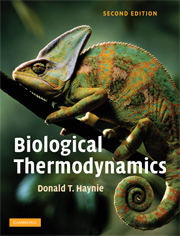Book contents
- Frontmatter
- Contents
- Preface to the second edition
- Chapter 1 Energy transformation
- Chapter 2 The First Law of Thermodynamics
- Chapter 3 The Second Law of Thermodynamics
- Chapter 4 Gibbs free energy – theory
- Chapter 5 Gibbs free energy – applications
- Chapter 6 Statistical thermodynamics
- Chapter 7 Binding equilibria
- Chapter 8 Reaction kinetics
- Chapter 9 The frontier of biological thermodynamics
- Appendices
- Glossary
- Index of names
- Subject index
- References
Chapter 1 - Energy transformation
Published online by Cambridge University Press: 05 June 2012
- Frontmatter
- Contents
- Preface to the second edition
- Chapter 1 Energy transformation
- Chapter 2 The First Law of Thermodynamics
- Chapter 3 The Second Law of Thermodynamics
- Chapter 4 Gibbs free energy – theory
- Chapter 5 Gibbs free energy – applications
- Chapter 6 Statistical thermodynamics
- Chapter 7 Binding equilibria
- Chapter 8 Reaction kinetics
- Chapter 9 The frontier of biological thermodynamics
- Appendices
- Glossary
- Index of names
- Subject index
- References
Summary
Introduction
Beginning perhaps with Anaximenes of Miletus (fl. c. 2550 years before present), various ancient Greeks portrayed man as a microcosm of the universe. Each human being was made up of the same elements as the entire cosmos – earth, air, fire, and water. Twenty-six centuries later, and several hundred years after the dawn of modern science, it is somewhat humbling to realize that our view of ourselves is fundamentally unchanged.
Our knowledge of the matter of which we are made, however, has become much more sophisticated. We now know that all living organisms are composed of hydrogen, the lightest element, and of heavier elements like carbon, nitrogen, oxygen, and phosphorus. Hydrogen was the first element to be formed after the Big Bang. Once the universe had cooled enough, hydrogen condensed to form stars. Then, still billions of years ago, the heavier atoms were synthesized by nuclear fusion reactions in the interiors of stars. We are made of “stardust.”
Our starry origin does not end there. For the Sun is the primary source of the energy used by organisms to satisfy the requirements of life (Fig. 1.1). Some organisms acquire this energy (Greek, en, in + ergon, work) directly; most others, including humans, obtain it indirectly. Even chemosynthetic bacteria that flourish a mile and a half beneath the surface of the sea require the energy of the Sun for life.
- Type
- Chapter
- Information
- Biological Thermodynamics , pp. 1 - 24Publisher: Cambridge University PressPrint publication year: 2008



